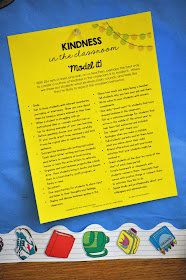I can recall many times in my career, as a student and as a
teacher, when someone’s kindness – a teacher’s, a classmate’s, a colleague’s –
made me feel more at ease and ultimately helped me be more successful. It’s no
different for our kids: Students tend to learn more in a kind, supportive
environment.
Besides, we’re educating not just the kids of our
classrooms, but the future citizens of the world! Given the current state of
affairs, we would do well to nurture kindness where we can. We can also celebrate
where it already exists. In our increasingly diverse classrooms, bringing out
the kindness already instilled in our kids can go a long way toward building
tolerance and respect.
#1 Write It!
Play “Pass the Compliment.” Begin by discussing what makes a
sincere compliment, and how to give specific praise. Explain to your students
that a comment like “good job” is less powerful than a comment that begins with
“I really liked the way you...” Once they’ve got the gist, have them put their
new skill into practice by writing specific, sincere compliments about their
classmates by passing around customized compliment collecting papers for each student.
When the students receive their customized, original compliments, stand back and watch them beam – my students talked about this for months after we did it!
Here's another idea. Help students write kind thank you notes to others. They could write them to classmates, members of the school community, or other important people in their lives. First, teach students HOW to write a thank you note. Help them understand the critical elements of a sincere note of thanks.
Then, you might want to take the note-writing a step further as they create fun thank you pockets.
The thoughtful notes and pockets will not only be treasured keepsakes, they're also simple ways to put kindness into words!
Great News! I've compiled a FREE resource filled with kindness activities. You can sign up and download it HERE.
#2 Spread It!
Here's another idea. Help students write kind thank you notes to others. They could write them to classmates, members of the school community, or other important people in their lives. First, teach students HOW to write a thank you note. Help them understand the critical elements of a sincere note of thanks.
Then, you might want to take the note-writing a step further as they create fun thank you pockets.
The thoughtful notes and pockets will not only be treasured keepsakes, they're also simple ways to put kindness into words!
Great News! I've compiled a FREE resource filled with kindness activities. You can sign up and download it HERE.
#2 Spread It!
We can create a sea of kindness – one drop at a time! Host a
Random Acts of Kindness challenge in your classroom to encourage students to
spread kindness at school, home and in the community.
In this activity, students perform four random acts of kindness and record their good deeds on “drops of kindness.”
The drops of kindness can be collected and displayed in the classroom as a reminder of the power and impact of small acts of kindness.
You could also have students perform acts of kindness and add them to strips of paper. Then, combine the strips of paper into a paper chain that you can display in your classroom. If you do the Random Acts of Kindness chain as a school-wide project, the chain could hang and weave its way through all the school hallways!
The drops of kindness can be collected and displayed in the classroom as a reminder of the power and impact of small acts of kindness.
You could also have students perform acts of kindness and add them to strips of paper. Then, combine the strips of paper into a paper chain that you can display in your classroom. If you do the Random Acts of Kindness chain as a school-wide project, the chain could hang and weave its way through all the school hallways!
#3 Read It!
I love the short story by Langston Hughes, “Thank You,Ma’am,” as a learning tool for reinforcing the transformative power of
kindness. Read this aloud (or have students read it to themselves) and chart
the ways in which Mrs. Jones’ kindness impacted the boy in the story. Then have
the students write a thank you note to someone who showed them a great
kindness. Or, check out this interactive notebook resource for teaching the short story.
Poetry is another great way to explore the theme of
kindness. Consider the following sampling of poems:
- ----- “Little Things” by Julia Fletcher Carney
- ----- “Love Between Brothers and Sisters” by Isaac
Watts
- ----- “The Ants” by
- ----- “Kindness to Animals” by Anonymous (as a side
note, include discussion of the Abraham Lincoln anecdote his friends recorded
about the time he stopped to save a young robin)
- ----- “To a Child” by William Wordsworth
Tape the poems onto chart paper and have students rotate in groups to each one. Have them silently record questions and reflections on the chart paper about what they’ve read and how it relates to kindness. You can even have them engage in a silent, written conversation.
#4 Model It!
With 25+ sets of eyes and ears on us teachers, perhaps the
best way to create a culture of kindness in the classroom is to model it. When
we show our students what kindness looks, sounds, and feels like, they’re
likely to repeat the modeled behaviors.
The best thing about kindness is that it truly is contagious. Infuse a little kindness in your classroom and watch how it begins to positively impact how students learn, care for others, and treat themselves.
Thanks for stopping by,




















No comments:
Post a Comment